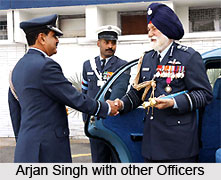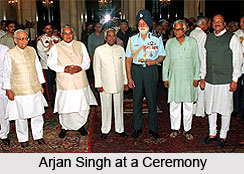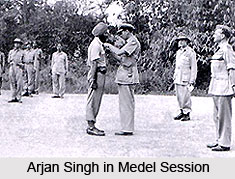 Arjan Singh, the Air Chief Marshal to the Indian Air Force had been through and experienced much to be elevated to the most sought after and esteemed position. He had fought competently in the pre-independence period, taking the Royal Air Force to sublime heights; he had competently fought his own war under IAF in the infamous Chinese and Pakistani assaults. In all, Singh left no stone unturned to have a fresh look towards life, from the sky. His flying career had taken him to different countries, after which he also had served as High Commissioner and Ambassador to various countries for the Indian government. Arjan Singh`s outlook and advice was always taken into account, which never did make this humble man condescending. In the meantime, Singh continuously climbed to prestigious positions in the Air Force rankings. It was ultimately time for him to be placed in the coveting and exceptional positions in Indian Air Force. The coronation of Arjan Singh as the Marshal in IAF was a gala and extraordinary affair, reminisced to this date.
Arjan Singh, the Air Chief Marshal to the Indian Air Force had been through and experienced much to be elevated to the most sought after and esteemed position. He had fought competently in the pre-independence period, taking the Royal Air Force to sublime heights; he had competently fought his own war under IAF in the infamous Chinese and Pakistani assaults. In all, Singh left no stone unturned to have a fresh look towards life, from the sky. His flying career had taken him to different countries, after which he also had served as High Commissioner and Ambassador to various countries for the Indian government. Arjan Singh`s outlook and advice was always taken into account, which never did make this humble man condescending. In the meantime, Singh continuously climbed to prestigious positions in the Air Force rankings. It was ultimately time for him to be placed in the coveting and exceptional positions in Indian Air Force. The coronation of Arjan Singh as the Marshal in IAF was a gala and extraordinary affair, reminisced to this date.
At Rashtrapati Bhavan, the period was post-colonial, but the setting was very much colonial. On April 23, 2002, a select gathering of the elite of India, top brass from the Indian Air Force, the Navy and the Army, as well as political leaders, civil servants and diplomats, alighted from their vehicles in the forecourt of the official residence of the President of India.
To be a part of the grand coronation of Arjan Singh, the high-rankers walked up the steps to the Ashoka Hall, past the six-feet tall soldiers of the President`s Body Guard (PBG) dressed in their traditional ceremonial uniform and accoutrements, that dated back to 1890. The blue-and-gold ceremonial turban with the distinctive `fan`, a white long-coat with gold girdles, white buckskin gauntlets, white breeches and Napoleon boots with spurs, all looked distinctive indeed.Each soldier had in his hand the special 10-feet 9-inch-long bamboo cavalry lance made especially for the PBG, carried in stirrup lance buckets adorned with the red-and-white cavalry pennant. The wings of a trained combat parachutist, in gold, adorned the breast of each member of this elite unit and medals glittered along with it.
 The stately four-storeyed Rashtrapati Bhavan possesses 340 rooms, but this day all eyes were fixed on the Ashoka Hall. It was originally built as the State Ballroom and the assembled guests walked on the polished wooden floor. Those seated under this imposing canopy included the then Vice-President Krishan Kant, then Prime Minister Atal Behari Vajpayee, then Home Minister Lal Krishna Advani, then Defence Minister George Fernandes, then External Affairs Minister Jaswant Singh, then Air Chief Marshal Srinivasapuram Krishnaswamy and a large number of retired and serving military officers.
The stately four-storeyed Rashtrapati Bhavan possesses 340 rooms, but this day all eyes were fixed on the Ashoka Hall. It was originally built as the State Ballroom and the assembled guests walked on the polished wooden floor. Those seated under this imposing canopy included the then Vice-President Krishan Kant, then Prime Minister Atal Behari Vajpayee, then Home Minister Lal Krishna Advani, then Defence Minister George Fernandes, then External Affairs Minister Jaswant Singh, then Air Chief Marshal Srinivasapuram Krishnaswamy and a large number of retired and serving military officers.
The PBG buglers sounded the fanfare from the central vestibules as a commencing gesture for coronation of the legendary Arjan Singh. Everybody in the Ashoka Hall stood up. The then President of India, K. R. Narayanan, was escorted to the room by his aides-de-camp, dressed in the finery of their office. The band then played the National Anthem. The hall has seen many glittering events, but none as the ongoing one. On this day, the first-ever Marshal of the Indian Air Force was to be presented his baton by the President of India. Marshal of the Indian Air Force Arjan Singh, DFC, had been named for this rarest of rare honours on January 26, 2002. This was the coronation ceremony for him and it meant a lot to everybody present, even though it had taken a while for it to happen.
A tall, handsome Sardar, sporting a milky white beard, wearing an Air Force uniform with five stars on the lapel, medals gleaming on his chest, marched up to the President with a definite stride. Arjan Singh confounded his 83 years and stood straight before the Supreme Commander of the Indian armed forces.
In a departure from the customary coronation ceremony protocol, but in keeping with the importance of the occasion, the then Defence Secretary, Yogendra Narain, read the citation that concluded thus - "His inspiring career, towering personality and distinguished reputation have endowed him with a unique stature in society and have earned him the respect of the nation.
 Even till date, he actively associates himself with various welfare activities of the Air Force as a father figure of the service, which he nurtured from its fledgling days. For his most outstanding and extraordinary service to the nation, the President of India is pleased to confer upon Air Chief Marshal Arjan Singh the rank of Marshal of the Indian Air Force."
Even till date, he actively associates himself with various welfare activities of the Air Force as a father figure of the service, which he nurtured from its fledgling days. For his most outstanding and extraordinary service to the nation, the President of India is pleased to confer upon Air Chief Marshal Arjan Singh the rank of Marshal of the Indian Air Force."
The President gladly acknowledged the salute of the veteran warrior. The baton was brought up on a velvet cushion. It was a magnificent creation that had borrowed the blue from the sky and had the glitter of gold gilding.
The President handed the baton to Marshal of the Air Force Arjan Singh, who saluted him back again. The President shook hands with him. They clasped each other`s hands for several minutes, thereafter as press photographers and television cameramen asked them to pose over and over again. The coronation ceremony of Arjan Singh had finally come up to be a true lavish affair, after years of fighting valiantly for his motherland.
Beaming with happiness was the lady of the day, Mrs. Teji Arjan Singh, in a russet organza sari. She had stood by her husband through the eventful years with grace and charm that have today become legendary. Sitting next to her in a white embroidered outfit was their daughter Asha. The National Anthem was played once more and the President and his guests retired to the Banquet Hall.
During tea at the Banquet Hall, adjoining the Ashoka Hall, the mood was informal.
Life-size portraits of past Presidents of India seemed to look upon the historic event approvingly as the coronated Marshal Arjan Singh was greeted by a large number of his well-wishers.
 The Prime Minister and the President gracefully conceded the centre stage to the 83-year-old pilot, who proudly wore the Distinguished Flying Cross, Padma Vibhushan and a host of other medals.
The Prime Minister and the President gracefully conceded the centre stage to the 83-year-old pilot, who proudly wore the Distinguished Flying Cross, Padma Vibhushan and a host of other medals.
This was absolutely Singh`s day. It was also a day for the Indian Air Force to be proud of an icon of the service had been honoured. India`s elite was present to commemorate the event and pay their respects to Marshal of the Indian Air Force Arjan Singh.
The Marshal of the Indian Air Force had managed to live a life in which he had incorporated various roles-he had originally received a King`s Commission in the Indian Air Force and had gone on to serve Independent India well. Commissioned by King George VI, honoured by both the British and the Indians, a superb flyer who was now a father figure, a soldier and a diplomat; this was evidently no ordinary man.




















